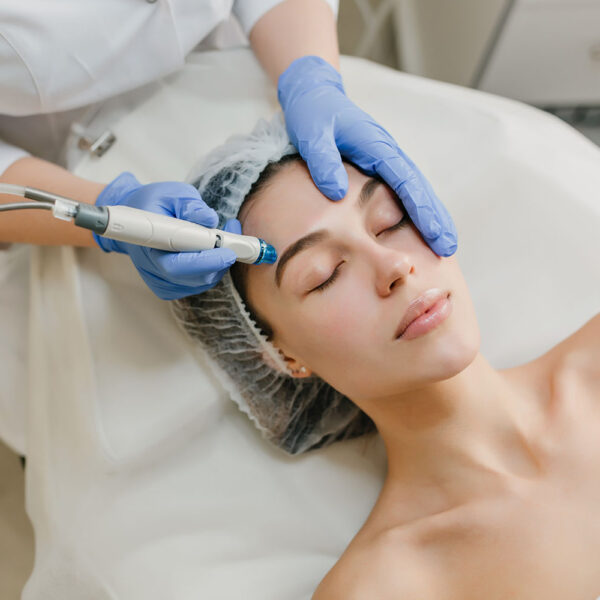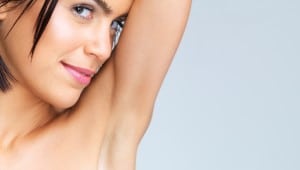These creams contain topical retinoids (retinol, adapalene, tretinoin, tazarotene) which are derivatives of vitamin A with proven value in skin renewal and antiaging. Another alternative are the creams that contain them fruit acids (AHA, BHA) which cause a mild peeling renewing the skin in the area.
But useful ingredients are the Vitamin C that gives shine, vitamin K to combat dark circles, the coenzyme Q10 which has an antioxidant effect, hyaluronic acid which hydrates, the caffeine to stimulate and stimulate microcirculation, aloe for soothing action, chamomile for anti-inflammatory action, gingo biloba to enhance microcirculation.
Before the minimally invasive microtrauma treatments (microneedling, fractional laser CO2, PDO threads, PLEXR) we stop the treatment with retinoid or acid fruit creams. We start re-using the cream when the irritation from the invasive treatment has passed (after 5-7 days).
When there is sunshine, sunscreen should be used in the morning
There are cases where dark circles are due to dermatological diseases. One chronic atopic eczema in the area of the eyelids it causes itching and repeated rubbing on the delicate skin of the area causes hyperpigmentation due to pigment deposition (hemoglobin which is released from injured skin capillaries when we rub our eyes). The same causes one irritant or allergic contact dermatitis in the eyelid area which is usually due to cosmetics (here to emphasize the importance of removing make-up every night with specialized make-up remover products). In these cases, our main concern is the treatment of the dermatological condition that causes the problem, followed by the improvement of the aesthetic problem
Other pathological causes include: anemias , hormonal changes-premenstrual syndrome or menopause (which are manifested by edemas, i.e. swelling of the eyelids). The eye allergies (eg conjunctivitis) As well as dry eye cause increased friction in the area by the patient resulting in pigment deposition. Also diseases related to the nose such as chronic allergic rhinitis, sinusitis, crooked diaphragm they cause chronic congestion due to poor drainage of tears in the nose resulting in venous congestion and the eyelids appearing puffy and black from insufficient oxygenation. In all these cases, the main goal is to treat the primary pathogenic cause.
Autologous mesotherapy PRP: PRP therapy is based on the use of the patient's own growth factors which are released from the platelets contained in the blood. The growth factors stimulate the fibroblasts of the skin to produce collagen and elastin, thus offering skin tightening and a thicker and better quality. Skin cells are also activated in the production of endogenous hyaluronic acid, which retains water molecules, offering hydration to the skin. The thicker and quality skin makes the skin vessels less visible resulting in an improvement in the image of dark circles. The PRP treatment is done by injection but can accompany and complement a minimally invasive method of microtrauma which is done in the periocular area (microneedling, fractional laser CO2, PDO threads, PLEXR) giving even better results in the application (due to the growth factors) and offering a lot faster recovery times.
Heterogeneous mesotherapy: Mesotherapy is an effective way to remove dark circles from the eyes. It improves the texture of the skin so we infuse substances like caffeine and ginko biloba, which provide hydration and lighten the dark tone. In another treatment protocol we use vitamin C in combination with DMAE and hydrating hyaluronic acid. Complete protocols require 4-6 treatment sessions. It is good to have a consultation session beforehand to decide which protocol is most suitable for each patient.
Hydrating Hyaluronic Acid: A very effective treatment is the use of injectable hyaluronic acid in the area of the lower eyelids. This hydrates the skin, which thickens and increases the distance of the skin from the vessels in the area, thus changing the shading of the lower eyelid. The result is usually impressive, but at least three treatment sessions are required.
Frax–Peel: This combination application is the latest in the field of piles. The micro trauma that creates the microneedling creates "gateways" for the chemical peel which achieves a much better penetration into the skin. So we can use milder peels which are completely safe, have very controlled exfoliation and very little skin irritation after application, can be done even in the summer months and have no recovery-recovery time, which with this combined application penetrate deeper and they have a much better effect similar to that of very strong chemical peelings. The peels we use are usually citric (derived from lemon) or combined citrate-mandelic (derived from bitter almond)
H application of threads grid support PDO in periocular area offers important additional improvement as well longer duration of effect in the initial application of botulinum toxin and hyaluronic acid.
Also, we apply the support threads as monotherapy in cases where they do not wish to apply botulinum toxin or hyaluronic acid, in which case we offer significant anatomical support to the area with the threads.
With a special application on the forehead, PDO threads can also contribute to the lifting of the eyebrow
Thread application can also be combined with application autologous PRP mesotherapy which significantly enhances the therapeutic effect.




















